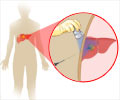Test of an interventional X-ray guidance device has the potential to reduce the radiation exposure of patients undergoing intra-arterial therapy (IAT) for liver cancer.

Geschwind says if further studies continue to affirm his team's findings, the platform may be especially useful for patients who need repeat therapy; children, who are especially vulnerable to radiation; and physicians who routinely use procedures such as IAT and are exposed to radiation.
During IAT, a physician inserts a thin, flexible tube directly into a blood vessel feeding a tumor, using that pathway to deliver chemotherapy or other drugs. X-ray imaging is used during the procedure to visualize the patient's blood vessels and to guide both the catheter's placement and drug delivery.
Geschwind and his colleagues compared the radiation exposure of 25 patients with liver cancer treated with IAT using the AlluraClarity platform to the exposure of 25 additional patients with liver cancer treated with IAT using Philips' previous X-ray imaging platform, called Allura.
Lowering the radiation power on standard X-ray imaging platforms can reduce the exposure, but without special image processing, the amount of image noise increases and physicians are unable to see small structures needed for good treatment, says Ruediger Schernthaner, M.D., a postdoctoral research fellow in vascular and interventional radiology at The Johns Hopkins Hospital. "You can compare this to an image taken with your cell phone in the evening without a flash," he says.
The AlluraClarity platform uses a series of real-time image processing algorithms to achieve high quality images at a lower radiation power, Schernthaner says.
Source-Eurekalert
 MEDINDIA
MEDINDIA




 Email
Email










